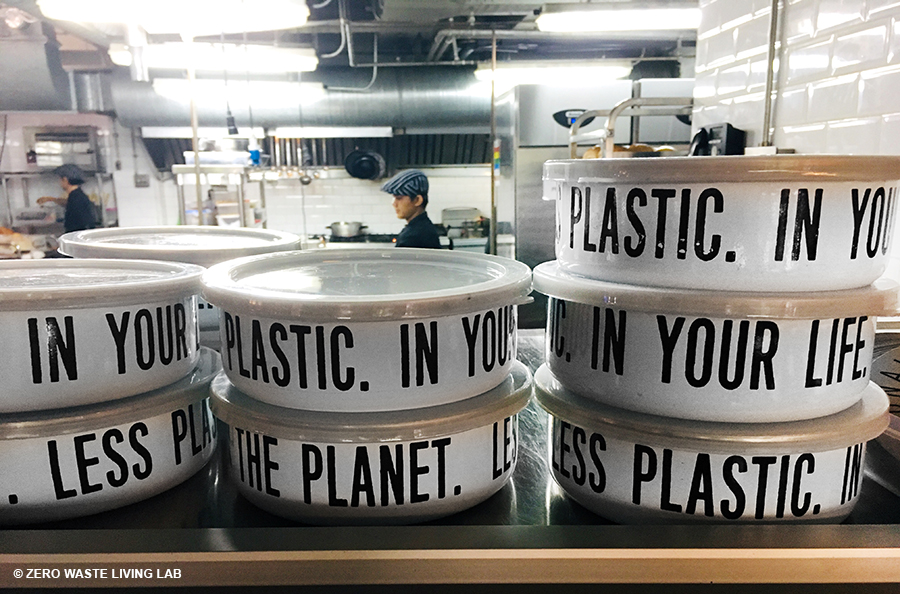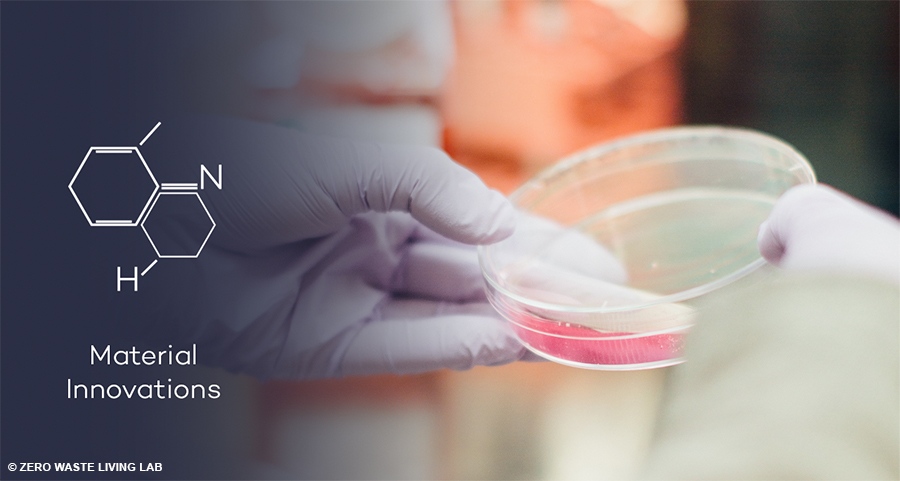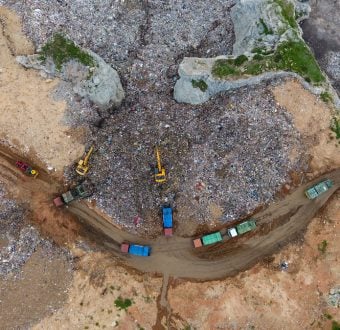This article is the third of six in our series, Going Plastic Free, to share how we can tackle the plastic pollution crisis by building a Zero Waste future with refuse, reduce and reuse businesses that reimagine the way we deliver, consume and pack products. Tune in next Thursday for the fourth installment.
Building an economy that is regenerative and restorative by design has the potential to unlock economic and ecological opportunities — here’s how.

Cutting single-use plastics is a main priority at the restaurant Kommunal 88 in Jakarta. They do so by reusable take-out containers, filtering their own well water, cloth napkins and only serving to-go coffee in tumblers.
Today, plastics are omnipresent materials in our social practices, economic relations, and the natural environment. On the one hand, lightness, low cost, and durability let us perceive plastics as a miracle material. On the other hand, the excessive usage of packaging, its disposal after only a few minutes of use and its accumulation and leakage into the environment coin it as the most transformative challenge of our century. A challenge that could lead to a radical change of our current markets with new innovations and business models playing a catalytic role.
Reuse is an economically interesting opportunity for about 20% of plastic packaging
Following research by the Ellen MacArthur Foundation (EMF), switching 20% of plastic packaging (by weight) with reusables could unlock striking market opportunities. Let’s calculate that based on one example: switching personal and homecare bottles and carrier bags would yield 6 million tonnes of material savings. Innovative product-delivery system models could save 80-90% on plastic packaging material, translating into an economic opportunity of $9 Billion.
Grasping the economic opportunity to reduce single-use plastic packaging turns out to be a potential market advantage as well: A recent survey by Statista in the UK shows that consumers are highly supportive of plastic packaging-free products in supermarkets.
The economic opportunity is likely to be accompanied by additional values such as increasing customer loyalty and interaction through reusable-service-systems. For example, subscription business models for reusable cups and containers bear the potential to strengthen long-term relationships with customers as the touchpoints increase with the usage lifetime of a product. This can be a great opportunity for companies to gain more consumer insights, increasing the user experience and overall satisfaction.
Reducing societal and natural capital costs as an incentive to build a new market
Cost savings are evident also from a societal and ecological perspective: reusable delivery models reduce environmental impacts and “preserve the natural resources upon which we all depend”. To understand that more precisely, let us dive into the hidden costs of plastic packaging by illustrating its environmental costs.
According to UNEP, plastic packaging of the consumer goods industry alone add up to $75 billion natural capital costs every year. With the plastics industry being mainly fossil-fuel based, these hidden environmental, economic and health costs derive from greenhouse gas emissions from raw material extraction, air pollution, biodiversity loss, land degradation and most of all ocean plastic pollution.
Plastic pollution of the ocean is the highest down-stream cost. Building new models that are regenerative and restorative by design could not only cut the environmental damage but also be vital to ensure the tourism and fisheries sectors. Especially in developing countries with a higher dependency on aquatic systems for livelihood.
Following the Asia-Pacific Economic Cooperation (APEC), ocean plastic pollution costs Asia’s tourism, fishing, and shipping industries $1.3 billion a year. Even in Europe, where leakage is relatively limited, degradation due to marine litter costs the EU tourism and recreation sector up to $720 million and $70 million for the fishery sector. With single-use plastics having a major share of 49% in this, the potential of economic gain is striking.
Identifying four key types of innovative business models in this new market
“What is needed is a paradigm of regenerative design – and that paradigm is now emerging, giving rise to a fascinating spectrum of business responses.”
Kate Raworth, Doughnut Economics: 214
The Zero Waste Living Lab identifies four potential business models that emerge as building blocks of a single-use plastic-free future:
A circular shopping experience with reuse & refill systems

Refill and reusable systems are business models that enable consumption with reusable packaging formats that are either owned by the consumer or the producer.
![]() Bring-Your-Own container proves to be scalable
Bring-Your-Own container proves to be scalable
The basic concept of Bring-Your-Own (BYO) container sounds niche, but the largest bulk food retailer BarnBulk has since 2016 proven its success on an extensive scale in 265 locations with more than 4,000 products from coast to coast in Canada. This makes them a front-runner in reimagining today’s shopping experience with the consumer as a key factor: “It’s immediately clear that zero-waste shopping is easy, organized and, most of all, welcome in their store.”
Smart cups that stay in the loop
Packaging-as-a-service systems reimagining the coffee habits of urban hotspots. Cups are supplied to stores, consumers take their drink to-go and drop it at collection points. No hassle to bring your own tumbler. A smart take-back infrastructure allows coordinating the collection and cleaning of the reusable cups.
Cup Club (cup-as-a-service in London), ReCup (deposit scheme for cups in Germany) and Revol.io (to-go container service system in Hong Kong and Bali) are currently leading the way to eliminate to-go packaging. The recent launch of TerraCycle’s Loop initiative, in which among others Procter & Gamble, Nestlé, PepsiCo and Unilever have committed to a reusable packaging e-commerce platform, is another example of a new paradigm shift of today’s shopping experience.
Shipping cleaning concentrate, not water
A new model that effectively cuts single-use plastics effectively is shown by Splosh. The e-commerce platform offers refill bottles and ships their home cleaning products as a concentrate. The consumer then adds water. Taking out water from the equation enables the company to drastically reduce plastic packaging and CO2-emissions for transport: “If the bottle is reused 20 times it means 95% less packaging waste.”
Circular consumption: Value chain innovations
These are innovative business models that significantly shorten the value chain, use resources all along the chain as efficient as possible and connect producers and consumers directly.

![]() Connecting producer and consumer
Connecting producer and consumer
The impact potential of these innovations is manifold by radically reducing the need for (excessive) single-use packaging, and also transport and cooling. Through farm-to-fork concepts such as The Food Assembly, with more than 8,000 local farmers that offer their produce online to about 2 million members that purchase directly through the e-commerce platform.
Produce is delivered weekly to an urban pick-up point for collection. “Some benefits are obvious: the food is fresher, healthier and often cheaper than the supermarkets. Others are less obvious: there is less plastic packaging, fewer food miles, more socializing.” Zero Waste delivery logistics services, like All Goods in Kopenhagen, could make this even more convenient.
Diapers-as-a-service
The consumption of disposable diapers has sky-rocketed with the vast majority not being recyclable. We see disrupting innovations starting in European countries: Washcot, for example, is a full-service platform where one subscribes for reusable diapers on a monthly basis. Weekly clean cloth diapers are delivered, and dirty ones are picked up. The supermarket is skipped, and producers and consumers interact directly while eliminating as much as 20kg of single-use diapers waste per month per baby.
Consumers become creators

Do-it-yourself (DIY) & home making solutions are business models that enable the consumer to make common food and non-food products at home, without purchasing packaged goods.
![]() Home growing with urban farming
Home growing with urban farming
Making transforms the consumers into creators. For example, Soda Stream enables the consumer to make sodas at home – eliminating the need to buy soda in single-use plastic bottles.
IKEA fuels the sustainable movement by mainstreaming indoor gardening with their latest hydroponic gardening and cultivation kits. People can grow their own lettuce and herbs at home. Moving beyond furniture a new kind of ownership over essential basic resources is enabled.
DIY cosmetics as a market gamechanger
Consumers are raising a growing concern about greenwashing and the ingredients in their cosmetic products. This concern is expressed in the growing customization of natural products and in the do-it-yourself movement, stores, and workshops for personal care products. Examples are DIY Soap in Amsterdam, where making your own products is no longer an act of consumption, but rather a happening and event with friends.
Along with this movement that strives for healthier and sustainable personal care products, single-use plastics are cut from the packaging formats. A greater shift to DIY products has the potential to eliminate plastic bottles from our bathrooms and travel bags. It could capture a share of the booming beauty and personal care market that was valued in 2017 with $455.3 billion.
Material Innovation: New materials for the reuse case
We believe the need for material innovation is also necessary to enable a reusable revolution. There is a need to radically innovate materials that are durable, affordable, hygienic, smart and practical for reusable delivery concepts.

![]() Smartification of reusable containers
Smartification of reusable containers
Material innovation is not only a demand to become a substitute for single-use plastics, but also key to build durable take-back infrastructures for reusables. Material innovation is starting to have integrated RFID chips sensors. Moreover, we discover reusable container innovations such as collapsible, durable, lightweight, fully recoverable, stainproof, odor free and self-cleaning surfaces and products that will be key for convenient reuse cases.
We have an economic opportunity to skip single-use plastics and there are new business models on the horizon
Skipping single-use plastic is an increasing economic opportunity and inspiring solutions are on the horizon that might change the way we consume forever – for the better. Current initiatives are still small and struggle with slow adoption rates and consumer reach.
To become available at a bigger scale they need a favorable innovation ecosystem and policy support. More concrete steps on this follow in the next blogs. The impact and business potential to skip single-use plastics are set — new innovative ventures are building the path towards a fascinating future without single-use plastics.
Within the Zero Waste Living Lab Indonesia, we scale, replicate and develop disruptive business models to make zero waste the new normal. This blog is part of a series of blogs that share how we can build the Zero Waste future with refuse, reduce and reuse businesses that reimagine the way we deliver, consume and pack products.

